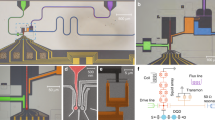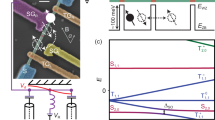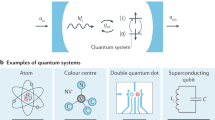Abstract
The fundamental concept of light–matter interaction is routinely realized by coupling the quantized electric field in a cavity to the dipole moment of a real or an artificial atom. A recent proposal1,2, motivated by the prospect of overcoming the decohering effects of distant charge fluctuations, suggests that introduction of and coupling to an electric quadrupole moment of a single electron can be achieved by confining it in a triple quantum dot. Here, we show an experimental realization of this concept by connecting a superconducting microwave resonator to the middle of the three dots, such that the dipole coupling becomes negligible. We demonstrate strong coupling to the electron quadrupole moment and determine that the coherence of our system is limited by short-range charge noise. Our experiment enables the construction and detection of a complex electronic state of a single electron in a solid-state environment that does not exist as such for a free electron.
This is a preview of subscription content, access via your institution
Access options
Access Nature and 54 other Nature Portfolio journals
Get Nature+, our best-value online-access subscription
$29.99 / 30 days
cancel any time
Subscribe to this journal
Receive 12 print issues and online access
$209.00 per year
only $17.42 per issue
Buy this article
- Purchase on Springer Link
- Instant access to full article PDF
Prices may be subject to local taxes which are calculated during checkout




Similar content being viewed by others
References
Friesen, M., Ghosh, J., Eriksson, M. A. & Coppersmith, S. N. A decoherence-free subspace in a charge quadrupole qubit. Nat. Commun. 8, 15923 (2017).
Ghosh, J., Coppersmith, S. N. & Friesen, M. Pulse sequences for suppressing leakage in single-qubit gate operations. Phys. Rev. B 95, 241307 (2017).
Wallraff, A. et al. Strong coupling of a single photon to a superconducting qubit using circuit quantum electrodynamics. Nature 431, 162–167 (2004).
Stockklauser, A. et al. Strong coupling cavity QED with gate-defined double quantum dots enabled by a high impedance resonator. Phys. Rev. X 7, 011030 (2017).
Mi, X., Cady, J. V., Zajac, D. M., Deelman, P. W. & Petta, J. R. Strong coupling of a single electron in silicon to a microwave photon. Science 355, 156–158 (2017).
Bruhat, L. E. et al. Circuit QED with a quantum-dot charge qubit dressed by Cooper pairs. Phys. Rev. B B98, 155313 (2018).
Viennot, J. J., Dartiailh, M. C., Cottet, A. & Kontos, T. Coherent coupling of a single spin to microwave cavity photons. Science 349, 408–411 (2015).
Mi, X. et al. A coherent spin–photon interface in silicon. Nature 555, 599–603 (2018).
Samkharadze, N. et al. Strong spin–photon coupling in silicon. Science 359, 1123–1127 (2018).
Landig, A. J. et al. Coherent spin–photon coupling using a resonant exchange qubit. Nature 560, 179–184 (2018).
Frey, T. et al. Dipole coupling of a double quantum dot to a microwave resonator. Phys. Rev. Lett. 108, 046807 (2012).
Vion, D. et al. Manipulating the quantum state of an electrical circuit. Science 296, 886–889 (2002).
Thorgrimsson, B. et al. Extending the coherence of a quantum dot hybrid qubit. npj Quantum Inf. 3, 32 (2017).
Zajac, D. M. et al. Resonantly driven CNOT gate for electron spins. Science 359, 439–442 (2018).
Yoneda, J. et al. A quantum-dot spin qubit with coherence limited by charge noise and fidelity higher than 99.9%. Nat. Nanotechnol. 13, 102–106 (2018).
Watson, T. F. et al. A programmable two-qubit quantum processor in silicon. Nature 555, 633–637 (2018).
Oi, D. K. L., Schirmer, S. G., Greentree, A. D. & Stace, T. M. Robust charge-based qubit encoding. Phys. Rev. B 72, 075348 (2005).
Kornich, V., Vavilov, M. G., Friesen, M. & Coppersmith, S. N. Phonon-induced decoherence of a charge quadrupole qubit. New J. Phys. 20, 103048 (2018).
Russ, M., Petta, J. R. & Burkard, G. Quadrupolar exchange-only spin qubit. Phys. Rev. Lett. 121, 177701 (2018).
Gasser, U. et al. Statistical electron excitation in a double quantum dot induced by two independent quantum point contacts. Phys. Rev. B 79, 035303 (2009).
Schuster, D. I. et al. ac Stark shift and dephasing of a superconducting qubit strongly coupled to a cavity field. Phys. Rev. Lett. 94, 123602 (2005).
Blais, A., Huang, R.-S., Wallraff, A., Girvin, S. M. & Schoelkopf, R. J. Cavity quantum electrodynamics for superconducting electrical circuits: an architecture for quantum computation. Phys. Rev. A 69, 062320 (2004).
van Woerkom, D. J. et al. Microwave photon-mediated interactions between semiconductor qubits. Phys. Rev. X 8, 041018 (2018).
Scarlino, P. et al. All-microwave control and dispersive readout of gate-defined quantum dot qubits in circuit quantum electrodynamics. Phys. Rev. Lett. 122, 206802 (2019).
Russ, M. & Burkard, G. Three-electron spin qubits. J. Phys. Condens. Matter 29, 393001 (2017).
Acknowledgements
We thank C. K. Andersen and M. Collodo for useful discussions and D. van Woerkom for his contribution to the sample fabrication. This work was supported by the Swiss National Science Foundation through the National Center of Competence in Research (NCCR) Quantum Science and Technology. S.N.C. and M.F. acknowledge support by the Vannevar Bush Faculty Fellowship programme sponsored by the Basic Research Office of the Assistant Secretary of Defense for Research and Engineering and funded by the Office of Naval Research through grant no. N00014-15-1-0029. M.R. and G.B. acknowledge funding from the Army Research Office (ARO) through grant no. W911NF-15-1-0149 and the DFG through grant SFB 767. M.F. and J.C.A.-U. acknowledge support by ARO (W911NF-17-1-0274). The views and conclusions contained herein are those of the authors and should not be interpreted as necessarily representing the official policies or endorsements, either expressed or implied, of the ARO or the US Government. The US Government is authorized to reproduce and distribute reprints for Governmental purposes, notwithstanding any copyright notation thereon.
Author information
Authors and Affiliations
Contributions
J.V.K., A.J.L. and P.S. fabricated the device. J.V.K. and A.J.L. performed the measurements with input from B.K. J.V.K. analysed the measurement data. J.V.K., J.C.A.-U. and M.R. wrote the manuscript with input from all authors. C.R. grew the heterostructure under the supervision of W.W. M.R. derived the input–output model under the supervision of G.B. J.C.A.-U. and M.R. developed the charge noise and magnetic field models under the supervision of G.B., M.F. and S.N.C. A.W., T.I. and K.E. supervised the experiment.
Corresponding author
Ethics declarations
Competing interests
The authors declare no competing interests.
Additional information
Publisher’s note Springer Nature remains neutral with regard to jurisdictional claims in published maps and institutional affiliations.
Supplementary information
Supplementary Information
Supplementary Figs. 1–3 and Discussion.
Source data
Source Data Fig. 2
Measurement and simulation data of Fig. 2
Source Data Fig. 3
Measurement and simulation data of Fig. 3
Source Data Fig. 4
Measurement and simulation data of Fig. 4
Rights and permissions
About this article
Cite this article
Koski, J.V., Landig, A.J., Russ, M. et al. Strong photon coupling to the quadrupole moment of an electron in a solid-state qubit. Nat. Phys. 16, 642–646 (2020). https://doi.org/10.1038/s41567-020-0862-4
Received:
Accepted:
Published:
Issue Date:
DOI: https://doi.org/10.1038/s41567-020-0862-4
This article is cited by
-
Coupling and readout of semiconductor quantum dots with a superconducting microwave resonator
Science China Physics, Mechanics & Astronomy (2023)
-
Quantum logic with spin qubits crossing the surface code threshold
Nature (2022)
-
Review of performance metrics of spin qubits in gated semiconducting nanostructures
Nature Reviews Physics (2022)



